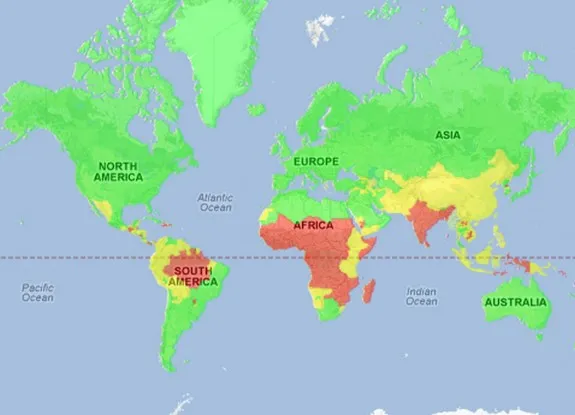In 2010, Malaria Killed 660,000 People, And Now It’s Resistant to the Drugs We Use to Fight It
Scientists have discovered a drug-resistant strain of malaria, and it’s spreading
/https://tf-cmsv2-smithsonianmag-media.s3.amazonaws.com/filer/2013042911302704_29_2013_malaria-net.jpg)
In 2010 alone, malaria infected 219 million people, largely in tropical regions in Africa, South and Central America, Asia and the Philippines. That year, the disease, caused by a parasite carried by mosquitos, killed 660,000 people. Objectively, that’s a high number of deaths, but compared to the number of infections, it’s relatively low. Right now, powerful anti-malarial medication protects those millions of infected people. But, says the BBC, a new strain of the parasite has been found in Cambodia that resists the leading class of anti-malarial drugs.
The new strain, first identified in 2008, is resistant to artemisinin, a “frontline drug in the fight against malaria,” the BBC writes. Since it was first discovered, the resistant version of malaria has spread around Southeast Asia. Health organizations are working hard to contain the spread of the drug-resistant variety: if the drugs are rendered ineffective, the consequences could be dire for millions of people.
This isn’t the first anti-malarial to be rendered useless, either. “The history of antimalarial medicine,” says the Mayo Clinic, “has been marked by a constant struggle between evolving drug-resistant parasites and the search for new drug formulations.”
Modern political history is already intertwined with the history of anti-malarial medications, and if drug-resistant strains of malaria continue to spread, they could prompt far-reaching changes. The advent of the first anti-malarial, says Glencoe World History, enabled European imperialism into tropical regions worldwide.
“Before 1850, the fear of disease was a major factor in keeping Europeans from moving into Africa. Especially frightening was malaria, an often fatal disease spread by parasites. …By 1850, European doctors had learned how to treat malaria with quinine, a drug that greatly reduced the death rate from the disease. Quinine is a bitter drug obtained from the bark of the cinchona tree, which is native to the slopes of the Andes in South America.”

Cinchona trees were transplanted from South America to India, and a steady supply of the drug enabled Europeans to move across Africa.
“By the beginning of the twentieth century, more than 90 percent of African lands were under the control of the European powers. A drug found in the bark of Latin American trees, which were then grown in Asia, had been used by Europeans to make possible their conquest of Africa.”
Since then, multiple generations of anti-malarial medication have come and gone (and researchers are still announcing promising new leads). But any time a drug-resistant strain like the one in Cambodia develops, it’s worth keeping an eye on.
More from Smithsonian.com:
Malaria Kills One Child Every 30 Seconds
Can Mosquitoes Fight Malaria?
A Conservative Estimate For Dengue Fever Infections in India: 37 Million Each Year
/https://tf-cmsv2-smithsonianmag-media.s3.amazonaws.com/accounts/headshot/smartnews-colin-schultz-240.jpg)
/https://tf-cmsv2-smithsonianmag-media.s3.amazonaws.com/accounts/headshot/smartnews-colin-schultz-240.jpg)